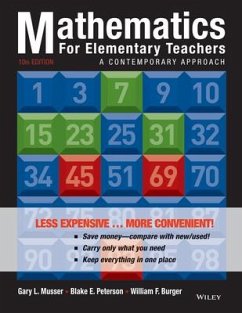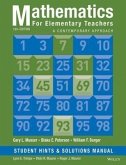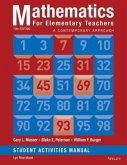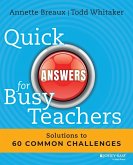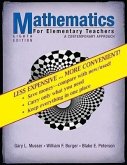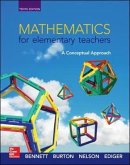Gary L Musser, Blake E Peterson, William F Burger
Mathematics for Elementary Teachers
A Contemporary Approach
Gary L Musser, Blake E Peterson, William F Burger
Mathematics for Elementary Teachers
A Contemporary Approach
- Loseblattsammlung
- Merkliste
- Auf die Merkliste
- Bewerten Bewerten
- Teilen
- Produkt teilen
- Produkterinnerung
- Produkterinnerung
Mathematics for Elementary Teachers, 10th Edition Binder Ready Version establishes a solid math foundation for future teachers. Thoroughly revised with a clean, engaging design, the new 10th Edition of Musser, Peterson, and Burgers best-selling textbook focuses on one primary goal: helping students develop a deep understanding of mathematical concepts so they can teach with knowledge and confidence. The components in this complete learning program--from the textbook, to the e-Manipulative activities, to the Childrens Videos, to the online problem-solving tools, resource-rich website and…mehr
Andere Kunden interessierten sich auch für
![Mathematics for Elementary Teachers, Student Hints and Solutions Manual Mathematics for Elementary Teachers, Student Hints and Solutions Manual]() Gary L MusserMathematics for Elementary Teachers, Student Hints and Solutions Manual89,99 €
Gary L MusserMathematics for Elementary Teachers, Student Hints and Solutions Manual89,99 €![Mathematics for Elementary Teachers: A Contemporary Approach 10e Student Activity Manual Mathematics for Elementary Teachers: A Contemporary Approach 10e Student Activity Manual]() Gary L MusserMathematics for Elementary Teachers: A Contemporary Approach 10e Student Activity Manual86,99 €
Gary L MusserMathematics for Elementary Teachers: A Contemporary Approach 10e Student Activity Manual86,99 €![Preparing Teachers for a Changing World Preparing Teachers for a Changing World]() Preparing Teachers for a Changing World41,99 €
Preparing Teachers for a Changing World41,99 €![Quick Answers for Busy Teachers Quick Answers for Busy Teachers]() Annette BreauxQuick Answers for Busy Teachers29,99 €
Annette BreauxQuick Answers for Busy Teachers29,99 €![Mathematics for Elementary Teachers: A Contemporary Approach Mathematics for Elementary Teachers: A Contemporary Approach]() Gary L. MusserMathematics for Elementary Teachers: A Contemporary Approach128,99 €
Gary L. MusserMathematics for Elementary Teachers: A Contemporary Approach128,99 €![Mathematics for Elementary Teachers Mathematics for Elementary Teachers]() Albert B BennettMathematics for Elementary Teachers265,99 €
Albert B BennettMathematics for Elementary Teachers265,99 €![Lectures on Elementary Mathematics Lectures on Elementary Mathematics]() La GrangeLectures on Elementary Mathematics36,99 €
La GrangeLectures on Elementary Mathematics36,99 €-
-
-
Mathematics for Elementary Teachers, 10th Edition Binder Ready Version establishes a solid math foundation for future teachers. Thoroughly revised with a clean, engaging design, the new 10th Edition of Musser, Peterson, and Burgers best-selling textbook focuses on one primary goal: helping students develop a deep understanding of mathematical concepts so they can teach with knowledge and confidence. The components in this complete learning program--from the textbook, to the e-Manipulative activities, to the Childrens Videos, to the online problem-solving tools, resource-rich website and Enhanced WileyPLUS--work in harmony to help achieve this goal. This text is an unbound, binder-ready edition. WileyPLUS sold separately from text.
Hinweis: Dieser Artikel kann nur an eine deutsche Lieferadresse ausgeliefert werden.
Hinweis: Dieser Artikel kann nur an eine deutsche Lieferadresse ausgeliefert werden.
Produktdetails
- Produktdetails
- Verlag: Wiley
- 10th Binder Ready Version edition
- Seitenzahl: 1040
- Erscheinungstermin: 16. September 2013
- Englisch
- Abmessung: 277mm x 213mm x 28mm
- Gewicht: 1919g
- ISBN-13: 9781118487006
- ISBN-10: 1118487001
- Artikelnr.: 40213936
- Herstellerkennzeichnung
- Libri GmbH
- Europaallee 1
- 36244 Bad Hersfeld
- gpsr@libri.de
- Verlag: Wiley
- 10th Binder Ready Version edition
- Seitenzahl: 1040
- Erscheinungstermin: 16. September 2013
- Englisch
- Abmessung: 277mm x 213mm x 28mm
- Gewicht: 1919g
- ISBN-13: 9781118487006
- ISBN-10: 1118487001
- Artikelnr.: 40213936
- Herstellerkennzeichnung
- Libri GmbH
- Europaallee 1
- 36244 Bad Hersfeld
- gpsr@libri.de
Gary Musser is Professor Emeritus of Mathematics at Oregon State University. Professor Musser has published 40 papers in many journals, including the PACIFIC JOURNAL OF MATHEMATICS. Blake E. Peterson is the author of Mathematics for Elementary Teachers: A Contemporary Approach, Binder Ready Version, 10th Edition, published by Wiley.
Preface xi
1 Introduction to Problem Solving 2
1.1 The Problem-Solving Process and Strategies 5
1.2 Three Additional Strategies 21
2 Sets, Whole Numbers, and Numeration 42
2.1 Sets as a Basis for Whole Numbers 45
2.2 Whole Numbers and Numeration 57
2.3 The Hindu-Arabic System 67
3 Whole Numbers: Operations and Properties 84
3.1 Addition and Subtraction 87
3.2 Multiplication and Division 101
3.3 Ordering and Exponents 116
4 Whole Number Computation-Mental, Electronic, and Written 128
4.1 Mental Math, Estimation, and Calculators 131
4.2 Written Algorithms for Whole-Number Operations 145
4.3 Algorithms in Other Bases 162
5 Number Theory 174
5.1 Primes, Composites, and Tests for Divisibility 177
5.2 Counting Factors, Greatest Common Factor, and Least Common Multiple 190
6 Fractions 206
6.1 The Set of Fractions 209
6.2 Fractions: Addition and Subtraction 223
6.3 Fractions: Multiplication and Division 233
7 Decimals, Ratio, Proportion, and Percent 250
7.1 Decimals 253
7.2 Operations with Decimals 262
7.3 Ratio and Proportion 274
7.4 Percent 283
8 Integers 302
8.1 Addition and Subtraction 305
8.2 Multiplication, Division, and Order 318
9 Rational Numbers, Real Numbers, and Algebra 338
9.1 The Rational Numbers 341
9.2 The Real Numbers 358
9.3 Relations and Functions 375
9.4 Functions and Their Graphs 391
10 Statistics 412
10.1 Statistical Problem Solving 415
10.2 Analyze and Interpret Data 440
10.3 Misleading Graphs and Statistics 460
11 Probability 484
11.1 Probability and Simple Experiments 487
11.2 Probability and Complex Experiments 502
11.3 Additional Counting Techniques 518
11.4 Simulation, Expected Value, Odds, and Conditional Probability 528
12 Geometric Shapes 546
12.1 Recognizing Geometric Shapes-Level 0 549
12.2 Analyzing Geometric Shapes-Level 1 564
12.3 Relationships between Geometric Shapes-Level 2 579
12.4 An Introduction to a Formal Approach to Geometry 589
12.5 Regular Polygons, Tessellations, and Circles 605
12.6 Describing Three-Dimensional Shapes 620
13 Measurement 644
13.1 Measurement with Nonstandard and Standard Units 647
13.2 Length and Area 665
13.3 Surface Area 686
13.4 Volume 696
14 Geometry Using Triangle Congruence and Similarity 716
14.1 Congruence of Triangles 719
14.2 Similarity of Triangles 729
14.3 Basic Euclidean Constructions 742
14.4 Additional Euclidean Constructions 755
14.5 Geometric Problem Solving Using Triangle Congruence and Similarity 765
15 Geometry Using Coordinates 780
15.1 Distance and Slope in the Coordinate Plane 783
15.2 Equations and Coordinates 795
15.3 Geometric Problem Solving Using Coordinates 807
16 Geometry Using Transformations 820
16.1 Transformations 823
16.2 Congruence and Similarity Using Transformations 846
16.3 Geometric Problem Solving Using Transformations 863
Epilogue: An Eclectic Approach to Geometry 877
Topic 1. Elementary Logic 881
Topic 2. Clock Arithmetic: A Mathematical System 891
Answers to Exercise/Problem Sets A and B, Chapter Reviews, Chapter Tests,
and Topics Section A1
Index i1
Contents of Book Companion Web Site
Resources for Technology Problems
eManipulatives
Spreadsheet Activities
Geometer's Sketchpad Activities
Technology Tutorials
Spreadsheets
Geometer's Sketchpad
Programming in Logo
Graphing Calculators
Webmodules
Algebraic Reasoning
Children's Literature
Introduction to Graph Theory
Additional Resources
Guide to Problem Solving
Problems for Writing/Discussion
Research Articles
Web Links
Videos
Book Overview
Author Walk-Through Videos
Children's Videos
1 Introduction to Problem Solving 2
1.1 The Problem-Solving Process and Strategies 5
1.2 Three Additional Strategies 21
2 Sets, Whole Numbers, and Numeration 42
2.1 Sets as a Basis for Whole Numbers 45
2.2 Whole Numbers and Numeration 57
2.3 The Hindu-Arabic System 67
3 Whole Numbers: Operations and Properties 84
3.1 Addition and Subtraction 87
3.2 Multiplication and Division 101
3.3 Ordering and Exponents 116
4 Whole Number Computation-Mental, Electronic, and Written 128
4.1 Mental Math, Estimation, and Calculators 131
4.2 Written Algorithms for Whole-Number Operations 145
4.3 Algorithms in Other Bases 162
5 Number Theory 174
5.1 Primes, Composites, and Tests for Divisibility 177
5.2 Counting Factors, Greatest Common Factor, and Least Common Multiple 190
6 Fractions 206
6.1 The Set of Fractions 209
6.2 Fractions: Addition and Subtraction 223
6.3 Fractions: Multiplication and Division 233
7 Decimals, Ratio, Proportion, and Percent 250
7.1 Decimals 253
7.2 Operations with Decimals 262
7.3 Ratio and Proportion 274
7.4 Percent 283
8 Integers 302
8.1 Addition and Subtraction 305
8.2 Multiplication, Division, and Order 318
9 Rational Numbers, Real Numbers, and Algebra 338
9.1 The Rational Numbers 341
9.2 The Real Numbers 358
9.3 Relations and Functions 375
9.4 Functions and Their Graphs 391
10 Statistics 412
10.1 Statistical Problem Solving 415
10.2 Analyze and Interpret Data 440
10.3 Misleading Graphs and Statistics 460
11 Probability 484
11.1 Probability and Simple Experiments 487
11.2 Probability and Complex Experiments 502
11.3 Additional Counting Techniques 518
11.4 Simulation, Expected Value, Odds, and Conditional Probability 528
12 Geometric Shapes 546
12.1 Recognizing Geometric Shapes-Level 0 549
12.2 Analyzing Geometric Shapes-Level 1 564
12.3 Relationships between Geometric Shapes-Level 2 579
12.4 An Introduction to a Formal Approach to Geometry 589
12.5 Regular Polygons, Tessellations, and Circles 605
12.6 Describing Three-Dimensional Shapes 620
13 Measurement 644
13.1 Measurement with Nonstandard and Standard Units 647
13.2 Length and Area 665
13.3 Surface Area 686
13.4 Volume 696
14 Geometry Using Triangle Congruence and Similarity 716
14.1 Congruence of Triangles 719
14.2 Similarity of Triangles 729
14.3 Basic Euclidean Constructions 742
14.4 Additional Euclidean Constructions 755
14.5 Geometric Problem Solving Using Triangle Congruence and Similarity 765
15 Geometry Using Coordinates 780
15.1 Distance and Slope in the Coordinate Plane 783
15.2 Equations and Coordinates 795
15.3 Geometric Problem Solving Using Coordinates 807
16 Geometry Using Transformations 820
16.1 Transformations 823
16.2 Congruence and Similarity Using Transformations 846
16.3 Geometric Problem Solving Using Transformations 863
Epilogue: An Eclectic Approach to Geometry 877
Topic 1. Elementary Logic 881
Topic 2. Clock Arithmetic: A Mathematical System 891
Answers to Exercise/Problem Sets A and B, Chapter Reviews, Chapter Tests,
and Topics Section A1
Index i1
Contents of Book Companion Web Site
Resources for Technology Problems
eManipulatives
Spreadsheet Activities
Geometer's Sketchpad Activities
Technology Tutorials
Spreadsheets
Geometer's Sketchpad
Programming in Logo
Graphing Calculators
Webmodules
Algebraic Reasoning
Children's Literature
Introduction to Graph Theory
Additional Resources
Guide to Problem Solving
Problems for Writing/Discussion
Research Articles
Web Links
Videos
Book Overview
Author Walk-Through Videos
Children's Videos
Preface xi
1 Introduction to Problem Solving 2
1.1 The Problem-Solving Process and Strategies 5
1.2 Three Additional Strategies 21
2 Sets, Whole Numbers, and Numeration 42
2.1 Sets as a Basis for Whole Numbers 45
2.2 Whole Numbers and Numeration 57
2.3 The Hindu-Arabic System 67
3 Whole Numbers: Operations and Properties 84
3.1 Addition and Subtraction 87
3.2 Multiplication and Division 101
3.3 Ordering and Exponents 116
4 Whole Number Computation-Mental, Electronic, and Written 128
4.1 Mental Math, Estimation, and Calculators 131
4.2 Written Algorithms for Whole-Number Operations 145
4.3 Algorithms in Other Bases 162
5 Number Theory 174
5.1 Primes, Composites, and Tests for Divisibility 177
5.2 Counting Factors, Greatest Common Factor, and Least Common Multiple 190
6 Fractions 206
6.1 The Set of Fractions 209
6.2 Fractions: Addition and Subtraction 223
6.3 Fractions: Multiplication and Division 233
7 Decimals, Ratio, Proportion, and Percent 250
7.1 Decimals 253
7.2 Operations with Decimals 262
7.3 Ratio and Proportion 274
7.4 Percent 283
8 Integers 302
8.1 Addition and Subtraction 305
8.2 Multiplication, Division, and Order 318
9 Rational Numbers, Real Numbers, and Algebra 338
9.1 The Rational Numbers 341
9.2 The Real Numbers 358
9.3 Relations and Functions 375
9.4 Functions and Their Graphs 391
10 Statistics 412
10.1 Statistical Problem Solving 415
10.2 Analyze and Interpret Data 440
10.3 Misleading Graphs and Statistics 460
11 Probability 484
11.1 Probability and Simple Experiments 487
11.2 Probability and Complex Experiments 502
11.3 Additional Counting Techniques 518
11.4 Simulation, Expected Value, Odds, and Conditional Probability 528
12 Geometric Shapes 546
12.1 Recognizing Geometric Shapes-Level 0 549
12.2 Analyzing Geometric Shapes-Level 1 564
12.3 Relationships between Geometric Shapes-Level 2 579
12.4 An Introduction to a Formal Approach to Geometry 589
12.5 Regular Polygons, Tessellations, and Circles 605
12.6 Describing Three-Dimensional Shapes 620
13 Measurement 644
13.1 Measurement with Nonstandard and Standard Units 647
13.2 Length and Area 665
13.3 Surface Area 686
13.4 Volume 696
14 Geometry Using Triangle Congruence and Similarity 716
14.1 Congruence of Triangles 719
14.2 Similarity of Triangles 729
14.3 Basic Euclidean Constructions 742
14.4 Additional Euclidean Constructions 755
14.5 Geometric Problem Solving Using Triangle Congruence and Similarity 765
15 Geometry Using Coordinates 780
15.1 Distance and Slope in the Coordinate Plane 783
15.2 Equations and Coordinates 795
15.3 Geometric Problem Solving Using Coordinates 807
16 Geometry Using Transformations 820
16.1 Transformations 823
16.2 Congruence and Similarity Using Transformations 846
16.3 Geometric Problem Solving Using Transformations 863
Epilogue: An Eclectic Approach to Geometry 877
Topic 1. Elementary Logic 881
Topic 2. Clock Arithmetic: A Mathematical System 891
Answers to Exercise/Problem Sets A and B, Chapter Reviews, Chapter Tests,
and Topics Section A1
Index i1
Contents of Book Companion Web Site
Resources for Technology Problems
eManipulatives
Spreadsheet Activities
Geometer's Sketchpad Activities
Technology Tutorials
Spreadsheets
Geometer's Sketchpad
Programming in Logo
Graphing Calculators
Webmodules
Algebraic Reasoning
Children's Literature
Introduction to Graph Theory
Additional Resources
Guide to Problem Solving
Problems for Writing/Discussion
Research Articles
Web Links
Videos
Book Overview
Author Walk-Through Videos
Children's Videos
1 Introduction to Problem Solving 2
1.1 The Problem-Solving Process and Strategies 5
1.2 Three Additional Strategies 21
2 Sets, Whole Numbers, and Numeration 42
2.1 Sets as a Basis for Whole Numbers 45
2.2 Whole Numbers and Numeration 57
2.3 The Hindu-Arabic System 67
3 Whole Numbers: Operations and Properties 84
3.1 Addition and Subtraction 87
3.2 Multiplication and Division 101
3.3 Ordering and Exponents 116
4 Whole Number Computation-Mental, Electronic, and Written 128
4.1 Mental Math, Estimation, and Calculators 131
4.2 Written Algorithms for Whole-Number Operations 145
4.3 Algorithms in Other Bases 162
5 Number Theory 174
5.1 Primes, Composites, and Tests for Divisibility 177
5.2 Counting Factors, Greatest Common Factor, and Least Common Multiple 190
6 Fractions 206
6.1 The Set of Fractions 209
6.2 Fractions: Addition and Subtraction 223
6.3 Fractions: Multiplication and Division 233
7 Decimals, Ratio, Proportion, and Percent 250
7.1 Decimals 253
7.2 Operations with Decimals 262
7.3 Ratio and Proportion 274
7.4 Percent 283
8 Integers 302
8.1 Addition and Subtraction 305
8.2 Multiplication, Division, and Order 318
9 Rational Numbers, Real Numbers, and Algebra 338
9.1 The Rational Numbers 341
9.2 The Real Numbers 358
9.3 Relations and Functions 375
9.4 Functions and Their Graphs 391
10 Statistics 412
10.1 Statistical Problem Solving 415
10.2 Analyze and Interpret Data 440
10.3 Misleading Graphs and Statistics 460
11 Probability 484
11.1 Probability and Simple Experiments 487
11.2 Probability and Complex Experiments 502
11.3 Additional Counting Techniques 518
11.4 Simulation, Expected Value, Odds, and Conditional Probability 528
12 Geometric Shapes 546
12.1 Recognizing Geometric Shapes-Level 0 549
12.2 Analyzing Geometric Shapes-Level 1 564
12.3 Relationships between Geometric Shapes-Level 2 579
12.4 An Introduction to a Formal Approach to Geometry 589
12.5 Regular Polygons, Tessellations, and Circles 605
12.6 Describing Three-Dimensional Shapes 620
13 Measurement 644
13.1 Measurement with Nonstandard and Standard Units 647
13.2 Length and Area 665
13.3 Surface Area 686
13.4 Volume 696
14 Geometry Using Triangle Congruence and Similarity 716
14.1 Congruence of Triangles 719
14.2 Similarity of Triangles 729
14.3 Basic Euclidean Constructions 742
14.4 Additional Euclidean Constructions 755
14.5 Geometric Problem Solving Using Triangle Congruence and Similarity 765
15 Geometry Using Coordinates 780
15.1 Distance and Slope in the Coordinate Plane 783
15.2 Equations and Coordinates 795
15.3 Geometric Problem Solving Using Coordinates 807
16 Geometry Using Transformations 820
16.1 Transformations 823
16.2 Congruence and Similarity Using Transformations 846
16.3 Geometric Problem Solving Using Transformations 863
Epilogue: An Eclectic Approach to Geometry 877
Topic 1. Elementary Logic 881
Topic 2. Clock Arithmetic: A Mathematical System 891
Answers to Exercise/Problem Sets A and B, Chapter Reviews, Chapter Tests,
and Topics Section A1
Index i1
Contents of Book Companion Web Site
Resources for Technology Problems
eManipulatives
Spreadsheet Activities
Geometer's Sketchpad Activities
Technology Tutorials
Spreadsheets
Geometer's Sketchpad
Programming in Logo
Graphing Calculators
Webmodules
Algebraic Reasoning
Children's Literature
Introduction to Graph Theory
Additional Resources
Guide to Problem Solving
Problems for Writing/Discussion
Research Articles
Web Links
Videos
Book Overview
Author Walk-Through Videos
Children's Videos

